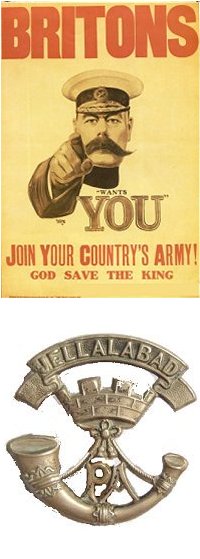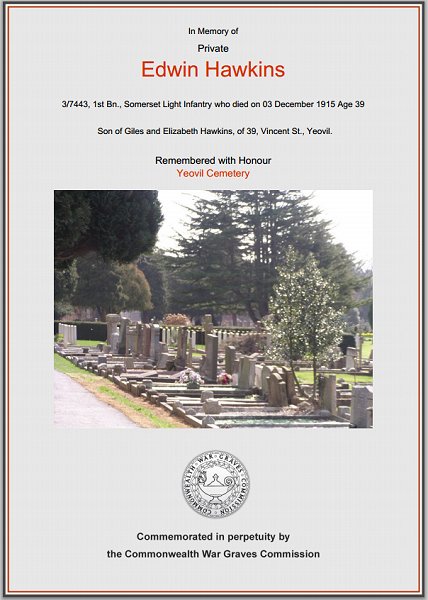yeovil at War
Edwin Giles Hawkins
Died in Yeovil
Edwin Giles Hawkins was born on 11 November 1877 at Yeovil, the son of Giles Hawkins (1848-1919) and Elizabeth née Baulch (1849-1935). By 1875, when he was 26 years old, Giles Hawkins, born in West Coker, was licensee of the Anchor Inn in Vicarage Street with his wife Elizabeth. In the 1881 census Giles and Elizabeth were living in the Anchor Inn with their two sons; 3-year old Edwin and 1-year old Arthur. By 1891 Giles, Elizabeth and their family were living next door to the Anchor Inn at 8 Vicarage Street. Giles was listed as a leather dresser and by now there were five children; Edwin aged 13, William A (presumably Arthur of the earlier census) aged 11, Mabel aged 8, Roland age 5 and 6-month old Leonard.
By the time of the 1911 census Giles and Elizabeth, both now aged 62, were living at 22 Vincent Street with their three unmarried sons Edwin, Arthur and Leonard, aged 33, 31 and 20 respectively. Edwin gave his occupation as an unemployed general labourer.
 It
is not known
when Edwin
enlisted,
although it is
known that he
enlisted at
Yeovil and it
was probably in
1914 since by
then he was aged
37 - the upper
limit for men
accepted into
the army. He was
Private Edwin
Hawkins (Service
No 3/7443) of
1st Battalion,
Somerset Light
Infantry. The
prefix '3' of
his service
number suggests
that he was
initially
enrolled into
the 3rd
(Territorial)
Battalion, but
later
transferred to
the 1st
(Regular)
Battalion.
It
is not known
when Edwin
enlisted,
although it is
known that he
enlisted at
Yeovil and it
was probably in
1914 since by
then he was aged
37 - the upper
limit for men
accepted into
the army. He was
Private Edwin
Hawkins (Service
No 3/7443) of
1st Battalion,
Somerset Light
Infantry. The
prefix '3' of
his service
number suggests
that he was
initially
enrolled into
the 3rd
(Territorial)
Battalion, but
later
transferred to
the 1st
(Regular)
Battalion.
At the outbreak of war in 1914 the 1st Battalion was in Colchester, with 11th Brigade, 4th Division. The Battalion landed at Le Havre, France with the British Expeditionary Force (BEF) on 22 August 1914. It is likely that Edwin would have joined his Battalion after his basic training, probably around the end of 1914.
In 1915 the 1st Battalion, Somerset Light Infantry fought in the Second Battle of Ypres.
The Second Battle of Ypres, 22 April-25 May 1915, was a rare German offensive on the Western Front during 1915. It was launched with two aims in mind. The first was to distract attention from the movement of German troops to the eastern front in preparation for the campaign that would lead to the victory of Gorlice-Tarnow. The second was to assess the impact of poisoned gas on the western front. Gas had already been used on the eastern front, at Bolimov (3 January 1915), but the tear gas used there had frozen in the extreme cold. At Ypres the Germans used the first lethal gas of the war, chlorine. The gas was to be released from 6,000 cylinders and would rely on the wind to blow it over the allied trenches. This method of delivery controlled the timing of the attack – the prevailing winds on the western front came from the west, so the Germans had to wait for a suitable wind from the east to launch their attack. The line around Ypres was held by French, Canadian and British troops. The attack on 22 April hit the French lines worst and, not surprisingly, the line broke under the impact of this deadly new weapon. The gas created a gap 8,000 yards long in the Allied lines north of Ypres. The success of their gas had surprised the Germans who didn’t have the reserves to quickly exploit the unexpected breakthrough, allowing enough time to plug the gap with newly arrived Canadian troops. During the battle the British, French and Canadians suffered 60,000 casualties, the Germans only 35,000.
Edwin Hawkins died in Yeovil on 3 December 1915. It is not really known if he died from wounds received at the Front, whether or not he was gassed, or died from other causes while in Yeovil. He was interred in Yeovil Cemetery, Grave B.3091 and his name is recorded on the War Memorial in the Borough.
gallery

The Commonwealth War Graves Commission certificate in memory of Edwin Hawkins.